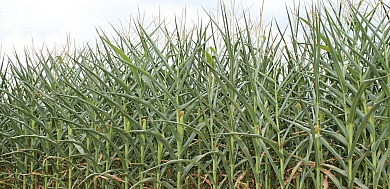WEST LAFAYETTE, Ind. — A return to more normal U.S. corn yields in 2013 could send new-crop prices spiraling downward, but persistent drought in some of the nation’s top corn-producing states, like Indiana and Ohio, could have the opposite effect.
The U.S. Department of Agriculture predicts the midpoint of U.S. farm prices on 2012 corn will be $7.60 per bushel. If yields are more normal in 2013, Purdue Extension agricultural economist Chris Hurt says prices could fall by $2.10 to $5.50 per bushel — the largest-ever year-to-year drop.
“The previous largest drop in the annual farm price was 73 cents per bushel for the 1986 crop,” he said.
“The percent reduction in 1986 was 33 percent, which would compare with a 28 percent reduction in 2013 if prices dropped to $5.50.”
Supply and demand
According to Hurt, late next summer a 2013 corn crop larger than 14 billion bushels would meet a usage base that has dropped to just 11.2 billion bushels. The market must then shift from rationing corn use from the current short crop to strongly increasing use.
If corn usage were to drop that low, it would take sharply falling prices to encourage end-users to return to normal usage.
“However, some of those end-users might be able to return to full usage at the flip of a switch, such as the ethanol industry,” Hurt said.
The domestic animal-feeding sector and the export sector won’t be able to build usage as quickly, and, Hurt said, increased corn production outside the U.S. will likely compete heavily with farmers for export business.
If drought persists
But normal 2013 U.S. corn production is nowhere near assured, especially if drought centered in the western Corn Belt and Great Plains states persists into the growing season.
Twenty-five percent of Minnesota, 42 percent of Iowa, 63 percent of South Dakota and 96 percent of Nebraska are in extreme to exceptional drought — the two worst categories. All four are among the top six corn-producing states.
“U.S. corn yields have been below trend for three years, and more farmers now recognize the possibility of four poor crops in a row,” Hurt said. “This, of course, means that normal crops and sharply lower prices are far from a reality.
“Prices won’t move sharply lower until crop production becomes more assured as the 2013 season progresses.”
Market reactions
Futures markets already are taking into account the possibility of a short 2013 corn crop and building in a greater-than-normal weather risk premium. While the amount of the premium is unknown, Hurt said 50 cents to $1 per bushel isn’t out of the question.
“As long as the drought threat remains as large as it is today, new-crop corn prices could stay higher by the risk premium,” he said. “If the drought risk were to be eliminated, then new-crop prices would likely drop.
“The weather threat could be reduced if more rain arrives but can’t be eliminated until next year’s corn growing season reaches mid- to late July.”
Uncertainty abounds
So while a return to normal production could mean $5.50-per-bushel corn, Hurt said continued drought in key production states could still translate to new-crop corn prices of $8.50 per bushel.
The uncertainty makes risk-management difficult for corn growers.
“Farmers will have three key tools to deal with the financial risk from this wide range of possible outcomes: federal crop insurance, the new government farm program and their own marketing decisions,” Hurt said.










